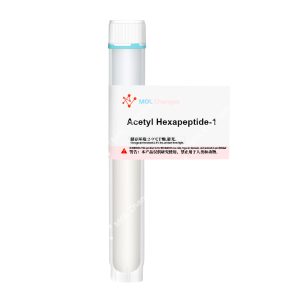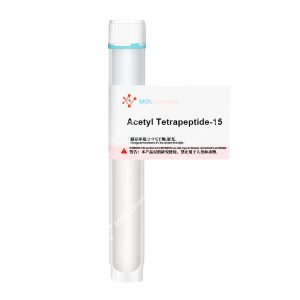Acetyl Hexapeptide-49 is a synthetic short-chain messenger peptide. Referred to as a “hexapeptide”, its molecular backbone comprises six amino acids linked together by peptide bonds; the N-terminal amino group is acetylated, primarily for increased stability and enhanced skin permeability. This peptide has gained widespread application in cosmetics and targeted skincare formulations, sensitive skin being one of the main conditions it is designed to address.
Sequence
Ac-Phe-Phe-Trp-Phe-His-Val-NH2
CAS Number
1969409-70-8
Molecular Formula
C51H58N10O7
Molecular Weight
923.07 g/mol
1.What is Acetyl Hexapeptide-49
The anti-sensitizing and soothing effects of Acetyl Hexapeptide-49 stem from its specific inhibition of a key signaling receptor – Protease-Activated Receptor 2 (PAR-2). PAR-2 itself is a G protein-coupled receptor, widely expressed on various skin cells and sensory neurons; it plays a central role in mediating skin inflammation, itching, and neurogenic inflammation.
Under normal conditions activation occurs through specific serine proteases (tryptase from mast cells being a prime example, environmental allergen proteases also serving this purpose). The cleavage of the N-terminal extracellular domain of PAR-2 exposes this novel sequence as a ‘tethered ligand’; binding back to the now activated receptor is what initiates the full cascade of downstream signaling.
Acetyl Hexapeptide-49 acts as a potent antagonist of this process, effectively disrupting the primary signaling pathway leading to sensitivity. Reductions in both IL-6 and Interleukin 8 (IL-8) inflammatory responses, and to a large degree TRPV-1 (and all that follows with CGRP) activation, are all direct effects of this inhibition.
2.Research Of Acetyl Hexapeptide-49
1)Alleviating Neurogenic Inflammation
Activation of PAR-2 stimulates sensory nerve endings to release multiple neuropeptides, calcitonin gene-related peptide (CGRP) being the primary one. CGRP serves as a potent vasodilator; skin redness, edema, and a characteristic burning sensation are all direct consequences of its release.
In vitro studies have shown acetylhexapeptide-49 to significantly inhibit PAR-2-triggered CGRP release, effectively controlling various forms of neurogenic inflammatory responses.
Human in vivo testing from suppliers demonstrates formulations containing it reducing (often completely alleviating) the stinging and burning sensations associated with specific chemical irritants – lactic acid and capsaicin being prime examples. Direct validation of a regulatory effect on sensory nerves is provided by these tests.
2)Inhibition of Inflammatory Cytokine Production
Within keratinocytes themselves, PAR-2 activation leads to the expression of a range of pro-inflammatory cytokines and chemokines (IL-6 being a well documented example, IL-8 also being highly relevant). Recruiting immune cells is part of the ensuing inflammatory response; reducing these mediators is a clear anti-inflammatory objective.
Experiments support the direct effect of Acetyl Hexapeptide-49 on these factors.
3)Restores skin barrier function
Chronic inflammation is a major cause of impairment to the skin’s natural barrier. Inhibiting the previously mentioned inflammatory pathways (PAR-2 being the initial trigger) allows for less damage to be done to this barrier, self repair can occur, and to a point external irritants will be met with a more ‘normal’ level of resistance.
3.Conclusion
Acetyl Hexapeptide-49 is a neuro-soothing peptide. All three lines of evidence point to it as a highly suitable candidate for treating or at least partially repairing sensitive skin.
COA
HPLC
MS









Reviews
There are no reviews yet.